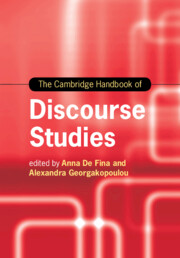Book contents
- The Cambridge Handbook of Discourse Studies
- Cambridge Handbooks in Language and Linguistics
- The Cambridge Handbook of Discourse Studies
- Copyright page
- Contents
- Figures
- Tables
- Contributors
- Preface
- Part I (Con)Textualizing Discourses
- Part II Perspectives and Modes of Analysis
- 6 Sequence Organization: Understanding What Drives Talk
- 7 Doing Micro-Analysis of Discourse: The Case of Ageing and Wellbeing
- 8 Corpus-Assisted Discourse Studies
- 9 Cognitive Linguistic and Experimental Methods in Critical Discourse Studies
- 10 Metaphor, Metonymy and Framing in Discourse
- 11 Poststructuralist Discourse Studies: From Structure to Practice
- Part III Discourse Materialities and Embodiment
- Part IV (Trans)Locations and Intersections
- Part V Ethics, Inequality and Inclusion
- Part VI Discourses, Publics and Mediatization
- Index
- References
7 - Doing Micro-Analysis of Discourse: The Case of Ageing and Wellbeing
from Part II - Perspectives and Modes of Analysis
Published online by Cambridge University Press: 28 September 2020
- The Cambridge Handbook of Discourse Studies
- Cambridge Handbooks in Language and Linguistics
- The Cambridge Handbook of Discourse Studies
- Copyright page
- Contents
- Figures
- Tables
- Contributors
- Preface
- Part I (Con)Textualizing Discourses
- Part II Perspectives and Modes of Analysis
- 6 Sequence Organization: Understanding What Drives Talk
- 7 Doing Micro-Analysis of Discourse: The Case of Ageing and Wellbeing
- 8 Corpus-Assisted Discourse Studies
- 9 Cognitive Linguistic and Experimental Methods in Critical Discourse Studies
- 10 Metaphor, Metonymy and Framing in Discourse
- 11 Poststructuralist Discourse Studies: From Structure to Practice
- Part III Discourse Materialities and Embodiment
- Part IV (Trans)Locations and Intersections
- Part V Ethics, Inequality and Inclusion
- Part VI Discourses, Publics and Mediatization
- Index
- References
Summary
Wellbeing is generally conceptualized as being essentially inner to an individual; discourse analysis would seem to have nothing to say here. In this chapter, we take the case of ageing and wellbeing as a case study for examining just what micro-analysis of interaction can offer us in terms of both understanding and researching states like wellbeing in later life. Drawing on the micro-analytic toolbox of conversation analysis, this chapter helps us see how wellbeing can be at least partly co-constructed in everyday interactions, specifically in quality interactions. The chapter examines some of the key findings of research into quality interaction among older populations in care settings and the links made to wellbeing. It then turns its attention to everyday settings in the community, still the majority experience for older people but the minority focus of interactionally orientated research studies. Discussions of such studies are interwoven with detailed analyses of naturally occurring audio-recorded interactions in a hair salon with older clients. Wellbeing, it is argued, is partly achieved through both the immediate fulfillment offered through talk – whether laughing together or telling troubles – and the positive identities that are afforded. The wider research implications are then discussed, in particular with respect to the ways in which interviews are used and the kinds of setting that need to be studied.
Keywords
- Type
- Chapter
- Information
- The Cambridge Handbook of Discourse Studies , pp. 143 - 164Publisher: Cambridge University PressPrint publication year: 2020
References
Further Reading
This collection encompasses studies of communication with older people in different care settings. The range of approaches allows readers to appreciate the insights afforded by different methods.
This is a very influential study in the field of discursive approaches to later life. The data are experimental, but the authors show clearly how detailed analysis of participants’ actual talk reveals more nuance about what is going on in particular exchanges than simple quantitative measures.
This collection offers multiple perspectives on narrative and older age, encompassing not only narrative as therapy but also the way different groups construct themselves through narrative.
This is an excellent collection of essays encompassing a wide range of aspects of communication and ageing. Although the chapters do not explicitly focus on wellbeing, many argue that wellbeing is at issue (for example those by Coupland and Grainger).
This volume explores representations of ageing from several different disciplinary perspectives. Although not all the authors adopt a strictly language-based discourse-analytic approach, the chapters, as a whole, offer insights into the way everyday discourses connect with wider societal discourses.

